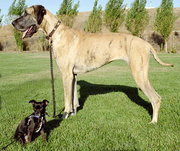Experimental evolution
|
|
In evolutionary biology, the field of experimental evolution is concerned with testing the theory of evolution in controlled experiments. Evolution can be observed in the laboratory as organisms adapt to new environmental conditions. With modern microbiological tools, it is possible to pinpoint the mutations that selection acts upon and what brought about the adaptations and to find out how exactly these mutations work. Because of the large number of generation required for adaptation to occur, evolution experiments are typically carried out with microorganisms such as bacteria or viruses.
| Contents |
Evolution experiments throughout human history

Unwittingly, humans have carried out evolution experiments for as long as they have been domesticating plants and animals. Selective breeding of plants and animals has led to varieties that differ dramatically from their original wild-type ancestors. Examples are the cabbage varieties, maize, or the large number of different dog breeds. The power of human breeding to create varieties with extreme differences from a single species was already recognized by Charles Darwin. In fact, he started out his book The Origin of Species with a chapter on variation in domestic animals. In this chapter, Darwin discussed in particular the pigeon. He wrote:
- "Altogether at least a score of pigeons might be chosen, which if shown to an ornithologist, and he were told that they were wild birds, would certainly, I think, be ranked by him as well-defined species. Moreover, I do not believe that any ornithologist would place the English carrier, the short-faced tumbler, the runt, the barb, pouter, and fantail in the same genus; more especially as in each of these breeds several truly-inherited sub-breeds, or species as he might have called them, could be shown him.
- (...) I am fully convinced that the common opinion of naturalists is correct, namely, that all have descended from the rock-pigeon (Columba livia), including under this term several geographical races or sub-species, which differ from each other in the most trifling respects."
Early experimental evolution
Dallinger_Incubator_J.R.Microscop.Soc.1887p193.png
One of the first to carry out a controlled evolution experiment was William Dallinger. In the late 19th century, he cultivated small unicellular organisms in a custom-build incubator over a time period of seven years (1880-1886). Dallinger slowly increased the temperature of the incubator from an initial 60 °F up to 158 °F. The early cultures had shown clear signs of distress at a temperature of 73 °F, and were certainly not capable of surviving at 158 °F. The organisms Dallinger had in his incubator at the end of the experiment, on the other hand, were perfectly fine at 158 °F. However, these organisms would not grow anymore at the initial 60 °F. Dallinger concluded that he had clearly found evidence for Darwinian adaptation in his incubator, and that the organisms had adapted to live in a high-temperature environment. Unfortunately, Dallinger's incubator was accidentally destroyed in 1886, and Dallinger could not continue this line of research.
Lenski's long-term evolution experiment with E. coli
On February 15, 1988, Richard Lenski started a long-term evolution experiment with the bacterium E. coli. The experiment continues to this day, and is by now probably the largest controlled evolution experiment ever undertaken. Since the inception of the experiment, the bacteria have grown for more than 20,000 generations. Lenski and colleagues regularly publish updates on the status of the experiments. A detailed list of publications and experimental protocols can be found on the project homepage [1] (http://myxo.css.msu.edu/ecoli/).
Experimental evolution today
Today, there is a vibrant experimental evolution community, and new papers on experimental evolution appear frequently in important scientific journals.
Further reading
- W. H. Dallinger (1887). The president's address. J. Roy. Microscop. Soc., 185-199.
- R. E. Lenski (2004). Phenotypic and genomic evolution during a 20,000-generation experiment with the bacterium Escherichia coli. Plant Breeding Reviews 24, 225-265.
- S. F. Elena and R. E. Lenski (2003). Evolution experiments with microorganisms: the dynamics and genetic bases of adaptation. Nature Reviews Genetics 4, 457-469.
- R. E. Lenski, M. R. Rose, S. C. Simpson, and S. C. Tadler (1991). Long-term experimental evolution in Escherichia coli. I. Adaptation and divergence during 2,000 generations. American Naturalist 138, 1315-1341.
